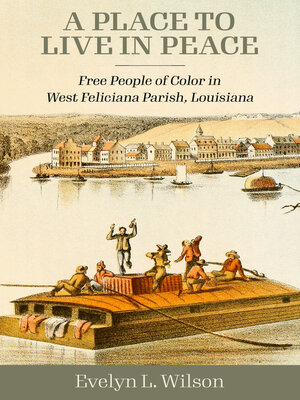A Place to Live in Peace
ebook ∣ Free People of Color in West Feliciana Parish, Louisiana
By Evelyn L. Wilson

Sign up to save your library
With an OverDrive account, you can save your favorite libraries for at-a-glance information about availability. Find out more about OverDrive accounts.
Find this title in Libby, the library reading app by OverDrive.



Search for a digital library with this title
Title found at these libraries:
| Library Name | Distance |
|---|---|
| Loading... |
A Place to Live in Peace: Free People of Color in West Feliciana Parish, Louisiana reveals a community where free people of color lived harmoniously with white people even as slavery persisted. Author Evelyn L. Wilson documents the presence, land ownership, business development, and personal relationships of free people of color in this Louisiana parish. In the last decade before the Civil War, tensions over slavery in West Feliciana Parish, Louisiana, led to the separation of free people of color from their white counterparts. But until the 1850s, free people of color had lived and thrived there.
The free people of color who inhabited West Feliciana Parish were not a settled population with a common background or a long history of freedom. Some entered the parish already free, others purchased their freedom, while others had been freed by slaveholders for differing reasons. Regardless of how they arrived in the parish, they found themselves in a community that valued the talents and skills they had to offer without regard to the color of their skin. These individuals were integrated into their community, lived among white neighbors, provided needed services, and owned successful businesses. Using extensive archival research, including court records, government documents, legal citations, and periodicals, Wilson interprets the lives, experiences, and contributions of free people of color in West Feliciana Parish. The integral role that these free people of color played in the parish complicates common understandings of the antebellum South.
The free people of color who inhabited West Feliciana Parish were not a settled population with a common background or a long history of freedom. Some entered the parish already free, others purchased their freedom, while others had been freed by slaveholders for differing reasons. Regardless of how they arrived in the parish, they found themselves in a community that valued the talents and skills they had to offer without regard to the color of their skin. These individuals were integrated into their community, lived among white neighbors, provided needed services, and owned successful businesses. Using extensive archival research, including court records, government documents, legal citations, and periodicals, Wilson interprets the lives, experiences, and contributions of free people of color in West Feliciana Parish. The integral role that these free people of color played in the parish complicates common understandings of the antebellum South.







